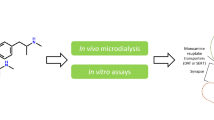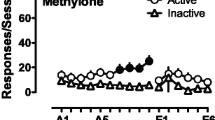Abstract
Clinical case studies suggest that combined administration of the serotonergic agent fenfluramine (FEN) and the weak amphetamine-like anorexic agent phentermine (PHEN) may be useful in the treatment of alcohol and cocaine addictions. The present experiment examined the nature of the interaction between the two agonists using the drug discrimination paradigm. In vivo microdialysis served to examine the neurochemical profile of dopamine and serotonin release in the nucleus accumbens. In conscious rats, acute injections of FEN (1.0–2.0 mg/kg IP) or PHEN (1.0–2.0 mg/kg IP) selectively elevated levels of serotonin and dopamine in the nucleus accumbens, respectively. A mixture (1 mg/kg of each) increased levels of both amines by similar magnitudes to those observed with each individually. Three groups of Sprague-Dawley rats were trained to discriminate (1) FEN (1.0 mg/kg IP) alone, (2) PHEN (1.0 mg/kg IP) alone or a mixture (3) PHEN+FEN (1 mg/kg of each, IP) from saline under a fixed ratio (FR-10) schedule of food reinforcement. Rats acquired the mixture discrimination rapidly, while for the other groups the training dose had to be increased to 2.0 mg/kg to attain stimulus control. The individual components of the mixture at the training dose generalized partially to the mixture, and complete generalisation was observed following 3.0 mg/kg FEN or PHEN. Rats trained to discriminate the individual components showed respective cross-generalisation profiles. Generalisation to cocaine (0.3–10.0 mg/kg IP), amphetamine (0.1–3.0 mg/kg IP) and nicotine (0.1–0.8 mg/kg SC) was greatest in the MIX-trained rats, while partial or no generalisation was observed in rats trained to discriminate the individual compounds. From the present results, it may be concluded that the two drugs given as a mixture do not produce a novel cue. Rather, these aminergics appear to interact additively. Furthermore, the dual stimulation of the amines by the mixture may be the basis for the cueing effects of the FEN+PHEN drug mixture, and its effectiveness in treating drug addictions.
Similar content being viewed by others
Author information
Authors and Affiliations
Additional information
Received: 4 October 1996/Final version: 12 December 1996
Rights and permissions
About this article
Cite this article
Shoaib, M., Baumann, M., Rothman, R. et al. Behavioural and neurochemical characteristics of phentermine and fenfluramine administered separately and as a mixture in rats. Psychopharmacology 131, 296–306 (1997). https://doi.org/10.1007/s002130050296
Issue Date:
DOI: https://doi.org/10.1007/s002130050296




